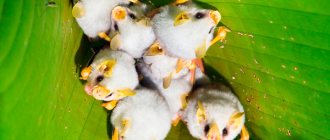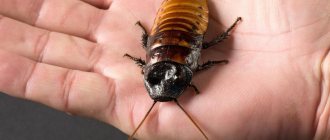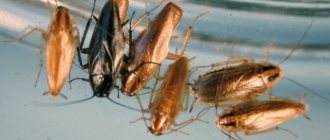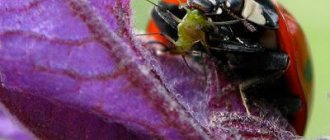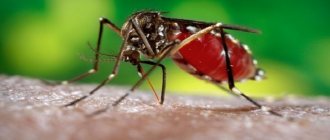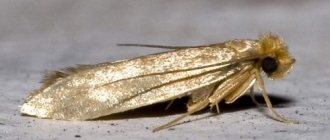The tarantula is a large spider whose body is covered with hair. The animal belongs to the wolf spider family and lives in dry areas such as steppes or deserts. During daylight hours it hides in fairly deep vertical burrows (up to 60 cm), at night it is active, climbs out and hunts insects. The tarantula spider does not weave a web in the form of a mesh; it only covers the walls of its burrows with it and uses it to build cocoons for eggs.
Tarantula at home - characteristics and features
Lovers of original pets often get spiders, because such a pet does not require a lot of attention and unobtrusive care. You can get quite a few types of spiders, and one of them includes a tarantula. Eccentric owners choose large spiders, for example, South American ones, while others prefer ordinary South Russian ones.
It is worth paying attention that it is better to get a female spider, since her life expectancy is much higher in comparison with males. Female South American tarantulas can live up to 30 years.
South Russian tarantula
This type of tarantula is the most common in Russia and Europe; some call it Mizgir. Female individuals reach a size of 2.5–3 cm, males are an order of magnitude smaller. The color of a spider can be different and directly depends on its habitat, for example: gray, brown, brown or red. The spider lives in steppe and forest-steppe zones, in deep vertical burrows.
Is the bite dangerous?
All species of tarantulas are poisonous to one degree or another, but the level of toxicity of their venom varies greatly depending on the type of spider, age, gender and season. Adult, sexually mature females (over 5 years old) of large species during mating and oviposition are considered the most poisonous. In all tarantulas, the toxicity of the venom increases between March and June and rapidly decreases starting in September. Usually, tarantula venom is no more dangerous for humans than wasp or hornet venom - redness and swelling appear at the site of the bite, symptoms disappear on their own, and there is no specific antidote.
In especially severe cases, there may be dizziness, nausea, and weakness. Such manifestations also go away on their own or are accompanied by symptomatic treatment. A separate case is an allergy to a toxin - in such a situation it is necessary to urgently consult a doctor or call an ambulance.
Appearance
The description of the tarantula is simple: the body of the spider is covered with hair, visually it can be divided into two parts - the cephalothorax and abdomen. There are four pairs of eyes on the head, allowing the spider to view its external environment at 360 degrees. Tarantulas are brown or black in color with red spots and stripes.
Female tarantulas are always much larger than males. The types of these spiders can be divided by size into small, medium and large. American representatives of this species reach a size of 10 cm, the size of their paws reaches 30 cm, while their European counterparts are much smaller in size. Females reach a size of about 4.5 cm, with paws up to 8 cm, and very small males grow to a maximum of 2.5 cm.
Biological certificate
Now let's move on to a description of the tarantula, the characteristics of its behavior, nutrition and reproduction, and give it a brief description as a representative of the animal world.
Scientific classification and lifestyle
The genus of tarantulas belongs to the wolf spider family. They live mainly in burrows, in which they spend all daylight hours, and at night they go out hunting. These arthropods also weave a web, but they use it not as a trapping net, but as a decoration for the walls of their underground apartments and for arranging an oviposition cocoon.
By the way! The depth of a tarantula's burrow can reach 60 centimeters, and some species are even capable of going a meter deep before the onset of cold weather!
Tarantulas are often confused with tarantula spiders, which is greatly facilitated by the fact that in some languages the word “tarantula” is used to refer to representatives of this family, and even if we ignore the differences in size, these arthropods are similar to each other.
Remember! Tarantula is from the wolf spider family, tarantulas are from the tarantula family!
The main difference between the two families is the structure and functioning of the chylicerae. In wolves they move towards each other, in tarantulas they move in parallel.
Description
What does a tarantula look like? These are quite large spiders, reaching a leg span of 30 centimeters. Males are always slightly smaller than females. The bodies of spiders are covered with hairs of gray, brown or brown color, depending on the species.
The largest sizes are tarantulas representing South America; their European relatives rarely exceed a body length of five centimeters.
An interesting question is about the organs of vision of representatives of this family. Curious lovers of the animal world are often interested in how many eyes a tarantula has. We answer - he has eight of them, which allows you to view the entire panorama around both horizontally and vertically.
Nutrition
It is also important to know what tarantulas eat. This is especially true for those lovers of arthropods who are going to breed them in their own apartment. And what, as the character in “The Twelve Chairs” said: “Who cares for a mare!”
So, the night hunter feeds on everything that is shorter. It could be an insect, an arachnid of another species, or even small mammals and birds. Digestion in tarantulas, like many other spiders, is external. First, the predator introduces poison and digestive juices into the body of the victim, which decompose the tissues of the victim, and only then absorbs the digested substrate.
Spreading
The question of where tarantulas are found is the most popular among arachnophobes, people who are afraid of spiders. In this regard, residents of central Russia and regions with similar or more severe climatic conditions can rest easy. Here the tarantula can only be found in various zoos and apartments of enthusiasts and Spider-Man fans.
But in the south of our country, our neighboring states, the south of Europe, the African, Asian and American continents, tarantulas are found in large numbers.
Reference! Currently, scientists have identified more than 200 species of tarantula spider.
Reproduction
Tarantula spiders reproduce like representatives of other spider families, but they still have their own characteristics. First of all, this is the famous mating dance, by which the spider recognizes the male of its own species. In general, the mating process can be divided into the following stages:
- At the end of summer, the male decides that it is time to extend his tarantula lineage and goes in search of a female.
- Having found the intended bride, he begins to perform a ritual dance.
- She, in turn, takes a closer look at the gentleman, and if she decides that he is the man of her dreams and belongs to the same species, she begins to respond to him, copying the dance steps.
- After such identification, mating itself occurs, after which the groom hurries to quickly retreat before the missus decides to eat him. It must be said that in this respect, male tarantulas are more agile than representatives of the male population of other spiders.
Next, the female finds a burrow suitable for wintering, where she spends the entire winter. With the onset of spring, she crawls out of her home and exposes her abdomen to the warm rays of the young sun.
In the female’s body, warmed by the warmth of the sun, eggs begin to form, up to 700 eggs depending on the species. At the end of this process, the female weaves a cocoon from the web directly on her stomach, where she places the formed eggs.
So she carries her offspring on herself until the young begin to hatch. Sensing this moment, the young mother gnaws through the cocoon and releases her children into the wild.
However, the babies do not leave their mother, but move onto her back, where she carries them until they learn to feed themselves.
Maintenance and care
A domestic tarantula should live in a small equipped terrarium. The size of the home directly depends on the size of the spider itself and should be twice the size of the pet. The temperature in the terrarium ranges from +18 to +30 degrees Celsius. You can choose peat as bedding. Tropical spider species prefer the litter to be slightly moist. Do not use wood or pine sawdust!
It is necessary to maintain humidity in the terrarium by spraying water over the substrate. Young spiders up to 12 months need this procedure at least once every 7 days. The spider also needs water; it can be poured into a regular saucer and placed in the terrarium.
It needs to be changed every day. It is better to place only one spider in one terrarium, even if they are of different sexes. For tarantulas living among trees, you can put branches so that the spider can climb on them and spin a web. The burrowing spider will appreciate peat bedding with great depth, which will allow it to dig burrows.
The terrarium should not be exposed to direct sunlight. During winter, the home should be heated with special equipment, and not with a lamp. Do not allow the air or bedding to dry out! The terrarium needs to be cleaned every few months. The spider needs to be moved to another place, for example, to a large jar and the bedding replaced with a new one. Once every six months, the entire home needs to be washed.
You cannot use any types of household chemicals; the cage can be washed simply with clean water.
Tarantula nutrition
In nature, a spider can feed on any living creature that is smaller than itself. Insects and small mammals are usually used as food. For an adult spider, one feeding per week will be enough. Breeders recommend mixing vitamins into food once every couple of months, and calcium gluconate every two weeks. The food is given directly to the spider's paws. You should not feed your tarantula pet cockroaches, street insects, frogs or mice.
A non-hungry domestic tarantula will not react to food, much less start hunting. Sometimes it happens that feeding needs to be stopped for a while. This must be done if the spider’s abdomen has increased several times in size. If feeding is not stopped, the tarantula may die from a ruptured abdomen.
What do they eat and what to feed the tarantula?
Tarantulas are predators that feed on large insects. At home, spiders are fed with live crickets, cockroaches, and larvae. When choosing food, you need to make sure that the prey is not larger than the predator itself, since spiders are very voracious and, trying to absorb too much food, can harm themselves, for example, their abdomen can burst. The younger the animal, the more often it eats. At the age of 1-2 years, the spider molts every 3 weeks, so it needs to be fed just as often. Subsequently, growth slows down and it is enough to feed 3-5 year old animals once every 1.5-2 months.
Lifestyle and its duration
Tarantulas lead a solitary lifestyle and carry fellow members of their species only during the mating season. Females and males treat each other with patience, while same-sex individuals cannot tolerate the presence of the other at all. Spiders live separately in their burrow and spend all daytime in it. Tarantulas usually hunt straight from their home; little will make the spider go far.
The lifespan of Mizgiri is about 3 years, and American tarantulas can live up to 30. Females, as a rule, live longer.
Is it possible to reproduce
Sexual maturity in females occurs 1.5-2 years later than in males. If for males this is 1.5-2 years, then for females it is 4-5 years. The mating period begins at the end of summer. After mating, the male usually dies, and the female begins to prepare for the winter. Female tarantulas lay eggs and place them in a silk cocoon, which is attached to the outside of the abdomen. “Gestation” lasts 40-50 days. During this period, under natural conditions, the female tries to be in the sun more often in order to speed up the incubation process; at home, it is worth raising the temperature in the terrarium to +30. +32 °C.
A clutch can contain from 50 to 500 eggs. After the incubation period is completed, the little spiderlings remain with their mother for another month, sometimes covering her entire body. After the expiration of a month, the babies leave the female and begin to lead an adult lifestyle. There are cases when the female herself drives away the young or even eats some part of it, so the babies need to be weaned on time.
Well, now you have the necessary knowledge on how to properly keep a tarantula at home, let this knowledge be useful to you, and remember: we are responsible for those we have tamed.
All spiders are predators. They feed mainly on insects. However, different species have, accordingly, different diets. When keeping a tarantula, you need to know what it eats in nature, as well as what you can and cannot feed it at home.

